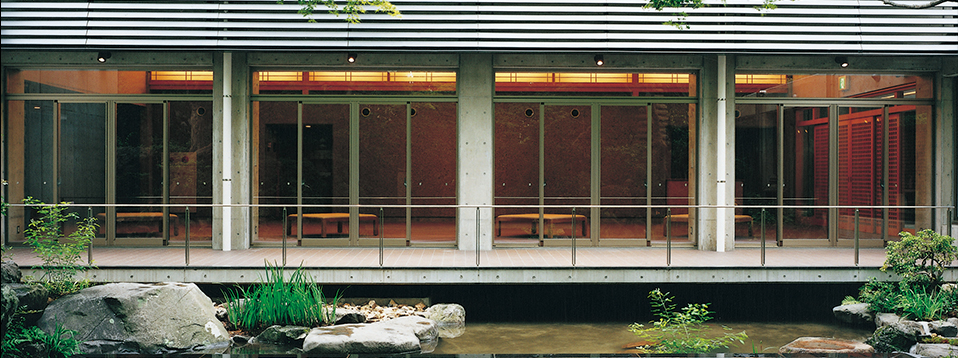
The Kongo Noh Theatre
The Kongo Noh Theatre, situated in the heart of the ancient capital of Kyoto near a site closely connected with the history of Noh, the Hana-no-gosho or ‘Flower Palace of Shogun Yoshimitsu, was completed in 2003. The previous theatre, with a history of over one hundred years of use, was carefully dismantled and rebuilt, retaining its unique ambiance of charm and tranquility. The repeated wave pattern seen on the wall of the hashigakari bridgeway is a copy of the pattern on the wall of the Noh stage that was on the Imperial Palace grounds and has been used since the past with the permission of the Imperial household. A stone stage stands beneath maple trees by the carp pond. The well-lit lobby space can also serve as a mini-gallery.
文化の香る町京都。金剛能楽堂は、その京都の中でも特に能楽と関わりの深い、かつての室町幕府の「花の御所」の近く(現在の京都御所の西向かい)に平成15年に開館しました。百四十余年の星霜を経た室町の金剛宗家邸内の旧金剛能楽堂より、先人の思いが詰まった能舞台をそのまま移築。21世紀の能楽堂の中に19世紀の舞台が融合する、時空を越えた空間が誕生しました。雅な雰囲気の漂う御簾席や、禁裏の舞台の面影を伝える橋懸りの青海波文様が、見所の趣きあるたたずまいを一層引き立てます。季節の移ろいを四季折々彩る庭園にしつらえた石舞台。心落ち着き、心華やぐひとときを金剛能楽堂でお過ごし下さい。
The Kongo School
Noh is a traditional theatre art of chant, dance, and music with a history of over six hundred years. The Kongo School, one of five schools of Noh shite-kata or main performers, has its origins in the traditions of the Sakatoh-za sarugaku troupe of the temples of Horyu-ji and Kofuku-ji in Nara. Sometimes called Mai-Kongo, or ‘Dance Kongo’, the School is known for the fluency and beauty of its dance style and for the vigor and athleticism of movement in some roles. The Kongo School also has a superb collection of masks and costumes. Among the masks, the women's masks Magojiro, used only by the Kongo School, and the Yuki-no-Ko-Omote, associated with Hideyoshi, are especially well-known. While the other Noh Schools based in Tokyo, the Kongo School remains in Kyoto.
In 2001 Noh was designated a World Cultural Heritage by UNESCO.
能楽は謡と囃子そして舞によって演じられる、六百年の歴史を持つ伝統芸能です。金剛流は能楽シテ方五流派のひとつで、古くは奈良の法隆寺に奉仕した猿楽座の坂戸座を源流とし、室町初期には春日興福寺に勤仕する大和猿楽四座のひとつとなり、のちに金剛座、そして現在の金剛流へと至りました。金剛流の芸風は、豪快で目ざましい動きの中にも、華麗・優美さがあり、「舞金剛」ともいわれます。また、豊臣秀吉拝領の「雪の小面」や艶麗な「孫次郎」など、金剛家の所蔵する能面・能装束に名品が多いことでも知られます。五流のうち四流の宗家が東京を本拠地としている中で、関西に宗家が在住する唯一の流儀です。
※平成13年、「能楽」はユネスコの第一回世界無形遺産に認定されました。
